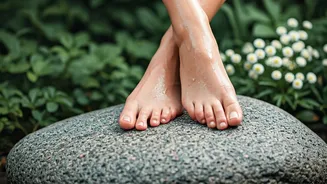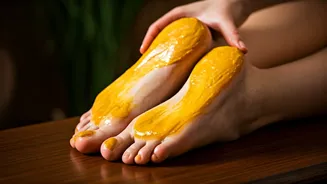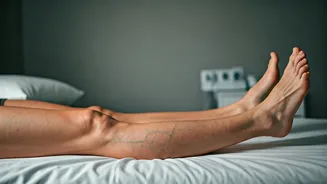Instant Relaxation
Foot massage serves as an excellent method for promoting deep relaxation. The feet, often overlooked, carry a significant burden throughout the day, enduring
strain from standing, walking, and various activities. A foot massage directly addresses this stress. When pressure is applied to the feet, it stimulates nerve endings that connect to different parts of the body. This stimulation helps to calm the nervous system, which then signals the brain to release endorphins, the body's natural painkillers and mood lifters. The simple act of massaging the feet can also reduce the levels of cortisol, the primary stress hormone. Consequently, the individual experiences a sense of tranquility and ease. Moreover, the rhythmic movements associated with foot massage encourage a feeling of being cared for, contributing to an overall sense of well-being.
Boosting Circulation
Improved circulation is a significant benefit derived from foot massage. The massage techniques work to enhance blood flow to the feet and legs, which is crucial for overall health. This process works by widening the blood vessels, allowing blood to move more freely. Additionally, foot massage can help to break up any blood clots or blockages that may be present, further improving circulation. Enhanced blood flow ensures that oxygen and nutrients are efficiently delivered to the body's cells, which facilitates optimal functioning. This is particularly beneficial for individuals who spend long periods standing or sitting, as it can help prevent the accumulation of fluids in the feet and legs. Furthermore, increased blood circulation can assist in regulating body temperature and enhancing metabolic processes, leading to better overall health.
Combating Inflammation
Foot massage is a helpful tool for reducing inflammation in the body. Inflammation often stems from physical exertion, injury, or underlying health conditions. By gently massaging the feet, one can effectively reduce swelling and discomfort. The massage techniques work to release built-up fluids and toxins from the tissues, which reduces inflammation. Increased circulation, induced by the massage, helps deliver the necessary nutrients and oxygen to the affected areas. This is crucial for initiating the healing process. Specific massage strokes can focus on the areas that are most affected, thus improving the overall effect. Regular foot massage can be an effective and natural way to manage inflammatory conditions, leading to improved comfort and mobility. The use of natural oils, such as apricot oil, can further enhance the anti-inflammatory benefits, making the massage more effective.
Skin Moisturisation, Repair
A foot massage can play a role in moisturizing and repairing dry skin. The feet are particularly susceptible to dryness and cracking, especially during the winter months when the skin is exposed to cold temperatures and low humidity. Applying massage techniques can help to stimulate the production of natural oils by the skin. This in turn, helps to restore the skin’s natural barrier. By using hydrating oils during the massage, such as apricot oil, the skin's moisture levels can be significantly boosted, and the skin can regain its suppleness. Regular foot massages help remove dead skin cells and promote the regeneration of new cells. This assists in healing cracked heels, preventing further dryness, and maintaining healthy, soft skin. Thus, foot massage is an effective treatment for maintaining the health and vitality of the skin on your feet.
Cosmetic Benefits, Too
Beyond its therapeutic benefits, foot massage also offers cosmetic advantages. Regular foot massage can improve the overall appearance of your feet by improving skin texture. Massaging the feet helps exfoliate dead skin cells, promoting smoother skin. The increased blood circulation brings essential nutrients and oxygen to the skin, thus, promoting a healthy glow. Foot massages can also help to reduce the appearance of calluses and corns by softening the skin and improving flexibility. The relaxation induced by massage can indirectly contribute to better skin health. By reducing stress, it can lead to improved skin clarity and a more vibrant appearance. Furthermore, regular massages can help reduce swelling and puffiness, leading to feet that look and feel rejuvenated. Incorporating foot massage into a routine offers both a sense of well-being and a boost to one's physical appearance.
Golden Remedy, Winters
Foot massage proves particularly beneficial during the colder months, serving as a 'golden' remedy for many winter-related issues. The colder temperatures and lower humidity during winter can lead to dry and cracked skin, especially on the feet. A regular foot massage, combined with hydrating oils, can combat these problems. The enhanced blood circulation that results from massage can also help to warm the feet and alleviate the discomfort associated with cold temperatures. During the winter, the body can experience increased stiffness and joint pain. Foot massage can ease these conditions by increasing flexibility and reducing muscle tension. In addition, the relaxation that foot massage provides can combat the effects of Seasonal Affective Disorder, which is common during the winter. Therefore, foot massage in winter offers a multifaceted approach to maintaining foot health, comfort, and overall well-being during the challenging weather.
Performing Right Massage
For an effective foot massage, one must adopt the right approach and techniques. Begin by creating a relaxing environment that includes a comfortable temperature and calming music. Start by warming your preferred massage oil, like apricot oil, between your palms. Gently apply the oil to the feet, starting with the toes and working down to the heel. Use a variety of massage strokes, such as kneading, circular motions, and gentle pressure. Focus on areas where you feel tension, and apply firm, but not painful, pressure. Pay special attention to the arches, heels, and balls of the feet. Use your thumbs and fingers to massage different points. Perform a gentle stretch to complete the massage. It's recommended to massage each foot for approximately 10-15 minutes. Consistent practice and proper technique, coupled with the right oil, ensure a soothing and therapeutic experience.












